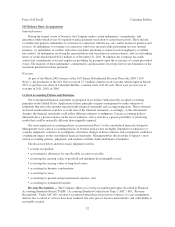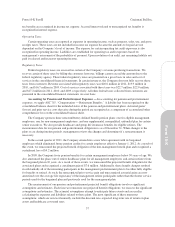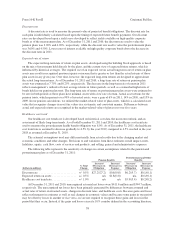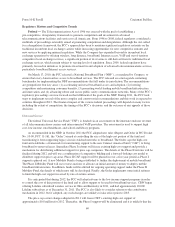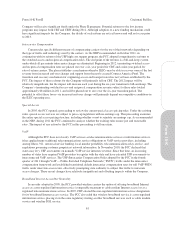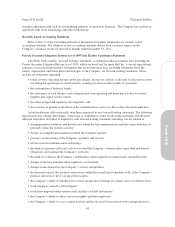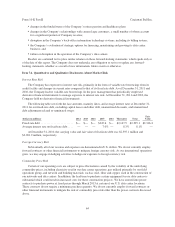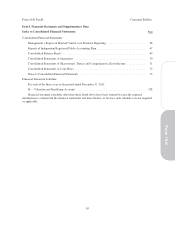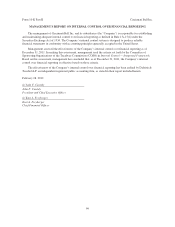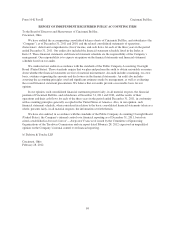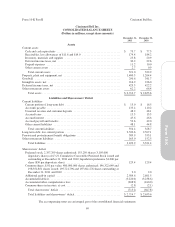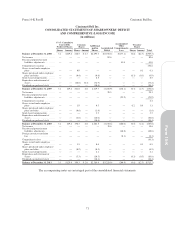Cincinnati Bell 2011 Annual Report Download - page 179
Download and view the complete annual report
Please find page 179 of the 2011 Cincinnati Bell annual report below. You can navigate through the pages in the report by either clicking on the pages listed below, or by using the keyword search tool below to find specific information within the annual report.
Form 10-K Part II Cincinnati Bell Inc.
Company will receive significant funds under the Phase II programs. Potential reforms to the low income
programs may impact both CBT and CBW during 2012. Although adoption of a new funding mechanism could
have significant impacts for the Company, the details of such reform are not yet known and will not occur prior
to 2013.
Intercarrier Compensation
Current rules specify different means of compensating carriers for the use of their networks depending on
the type of traffic and technology used by the carriers. As the NBP recommended, in October 2011, in
conjunction with its reform of the USF high cost support program, the FCC adopted comprehensive reforms to
the switched access and reciprocal compensation rules. The end point of the reforms is a bill-and-keep system
under which all per-minute intercarrier charges are eliminated. Beginning in 2012, terminating switched access
and reciprocal compensation rates are phased out over a six-year period for CBT and a nine-year period for
rate-of-return carriers. The plan establishes a mechanism whereby ILECs may be able to recover some of the lost
revenue from increased end-user charges and support from the newly created Connect America Fund. The
transition and recovery mechanism for originating access and transport rates has not yet been established by the
FCC. The impact of these reforms for the Company will primarily fall on CBT. The 2012 impact will be
relatively insignificant, but the impact will increase each year during the six-year transition to bill-and-keep. The
Company’s terminating switched access and reciprocal compensation revenue subject to these rules totaled
approximately $8 million in 2011, and will be phased out to zero over the six-year transition period. The
potential to offset these losses via increased end-user charges will primarily depend on competitive conditions in
the ILEC operating area.
Special Access
In 2005, the FCC opened a proceeding to review the current special access pricing rules. Under the existing
rules, special access services are subject to price cap regulation with no earnings cap. This proceeding examines
the entire special access pricing structure, including whether or not to reinstate an earnings cap. As recommended
in the NBP, during 2011 the FCC continued to analyze whether the existing rules ensure just and reasonable
rates. The impact of any action by the FCC in this proceeding is still uncertain.
VoIP
Although the FCC does not classify VoIP services as telecommunications services or information services,
it has applied many traditional telecommunications service obligations to VoIP service providers, including,
among others, 911, universal service funding, local number portability, telecommunications relay service, and
regulations governing customer proprietary network information. In November 2010, the FCC declared that
states may levy USF assessments on nomadic VoIP service intrastate revenue. Since that time, an increasing
number of states have required VoIP providers to register with the state and have extended USF assessments to
interconnected VoIP services. The USF /Intercarrier Compensation Order adopted by the FCC in the fourth
quarter of 2011 brought VoIP — Public Switched Telephone Network (“PSTN”) traffic under the intercarrier
compensation framework and established transitional default intercarrier compensation rates for toll VoIP-PSTN
traffic under interstate access rates, effectively preempting state authority to subject this traffic to intrastate
access charges. These recent changes have relatively insignificant and offsetting impacts within the Company.
Broadband Internet Access/Net Neutrality
In an order adopted in 2005, the FCC provided wireline carriers the option of offering broadband Internet
access as a non-regulated information service (comparable treatment to cable modem Internet access) or as a
regulated telecommunications service. In 2007, CBT elected the non-regulated information service designation
for its broadband Internet access service. The FCC also ruled that wireless broadband service is a non-regulated
information service, placing it on the same regulatory footing as other broadband services such as cable modem
service and wireline DSL service.
61
Form 10-K



